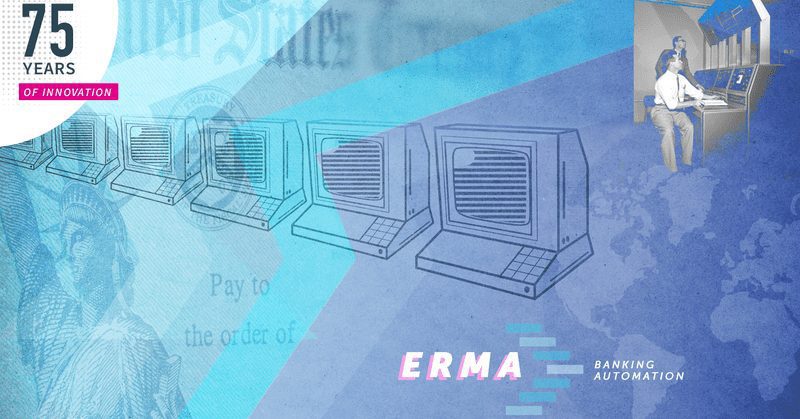A system to provide automated handling of personal checking accounts
The 75 Years of Innovation series highlights the groundbreaking innovations spanning from SRI’s founding in 1946 to today. Each week, SRI will release an innovation, leading up to its 75th anniversary in November 2021.

A banking baby boomer: How SRI helped the Bank of America to become the first automated bank
Banking has come a long way since the first bank in Assyria, 2000 years ago. Throughout the last two millennia, banking has continually evolved, especially over the last century. Technologies such as robotic process automation (RPA) have changed how modern banking works, and early automation technologies laid the groundwork for the seamless digital banking of the 21st century. The first wave of banking automation came in the 1950s when SRI developed the first integrated system for processing checks.
Born in the 1950s, the modern automated banking system is a true baby boomer. Here is how SRI’s innovations laid the foundation for the way we bank today.
SRI and Bank of America automate personal checking
In the 1950s, computers were the size of a large room. The idea of taking this massive piece of technology and using it in the commercial context of banking took real vision. The post-war period of the late 1940s and 50s saw a booming economy that helped raise many Americans’ economic power. Banking needed to grow and develop to handle a rapid increase in consumer financial transactions. At the same time, banking customers began to demand more of their banks and the services they provided, and this demand drove banking innovation.
The buoyant economy of the 1950s led to a surge in the number of checking accounts, straining the back-office systems that processed checks. At this time, check processing involved a human being manually examining and processing every check to ensure all was well and completing the paper transaction process. Banks would have several people working purely on processing in the bank’s back room to manage this workload. With an increase in the demand for checking services combined with a growing economy and cumbersome manual processing, something had to give. This slow, manual, back-room process was a perfect candidate for automation.
Bank of America, the largest bank in the world at the time, turned to SRI International to help solve the overload created by manual check processing. In 1955, SRI and Bank of America unveiled ERMA, the electronic recording machine and accounting system. ERMA combined and coordinated many components to automate check processing, including another SRI innovation, magnetic ink character reading (MICR).
ERMA, the big beast of automation
Automation has revolutionized the way banks operate, and ERMA was a milestone in this process. In the 1955 SRI newsletter, Research for Industry, ERMA was described as a new “electronic bookkeeper” developed out of war-time research into “electronic brains.” ERMA was made up of components reflecting innovation in magnetic recording, machine reading of printed codes, paper-handing mechanisms and high-speed printing. Fortunately, SRI already had experience with all of these systems. One of the key hurdles, however, was in bringing the various components needed for check handling together into one seamless, automated process flow.
The multi-component ERMA system depended on the development of machine-reading of codes and characters printed in ink. This, in turn, required the development of magnetic ink, allowing for an accurate reading of characters within the automation process. The 1955 SRI Newsletter describes the behemoth ERMA system:
“ERMA includes more than one million feet of wiring, 34,000 diodes, 8,000 vacuum tubes, and weighs in the neighborhood of 25 tons.”
ERMA would produce a seamless flow that reduced check processing time by 80%.
The mechanics of automation that is ERMA and the machine-readable check
ERMA comprises several interconnected parts, including five keyboards used to input the checking data. These devices’ keys were designed to reflect the account numbers, check amount and other related data. A computational unit translated key pushes into codes, with four circuits providing enough on/off combinations to recognize all ten digits and several symbols.
Two magnetic drums (the size of small oil drums) recorded temporary information files. Each drum was coated in a fine resin of iron oxide, the polarity of which was controlled with a magnetic field. Each drum was sub-divided into 300 parallel tracks, and each track was divided into sections of 0.01 inch (0.25mm) long. The resulting 1.5 million magnetic cells held the information encoded as bits in ERMA’s binary system.
The magnetic ink, developed as part of SRI’s research for Bank of America, provided the machine-readable part of the check, allowing ERMA to read each check automatically. Each check was imprinted with this magnetic ink on the back. The magnetic ink, known as the MICR line, was used to identify the details of a check. The MICR line included data on the document type, bank code, bank account number, check number, amount, etc. The characters printed in magnetic ink could be read by ERMA at the rate of 1000 per second.
At the time of its introduction, ERMA was able to service 32,000 accounts per day. When ERMA became operational on September 14, 1959, processing had increased to 50,000 accounts per day. ERMA continued to be used in banking automation into the 1970s.
Bank of America and SRI took on the puzzle of banking automation and resolved it in the form of ERMA and magnetic ink. This milestone on the long road to bank automation has ultimately led to the highly digitized and automated banking systems of the 21st century.
Resources
1955 SRI newsletter, Research for Industry: http://ed-thelen.org/comp-hist/SRI_Newsletter_Oct55-1.pdf
Fischer and McKenney: The Development of the ERMA Banking System: Lessons from History: http://ed-thelen.org/comp-hist/Dev-of-ERMA–LessonsFromHistory.pdf


